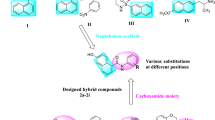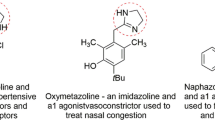Abstract
Ten (E)-and (Z)-isomers of 2-phenylcyclopropylamine (PCA), 1-Me-PCA, 2-Me-PCA, N-Me-PCA, and N, N-diMe-PCA and fifteeno −, m−, p− isomers of (E)-PCA with substituents of Me, Cl, F, OMe, OH were synthesized in this laboratory and tested for the inhibition of rat brain mitochondrial MAO-A and MAO-B. The effects of substituents, their positions, and stereochemistry on the inhibition were assessed for the compounds with substituents at cyclopropyl and amino groups and QSAR analyses were performed using the potency data of ring-substituted compounds. The best correlated QSAR equations are as follows: pI50=0.804 Π2 Blo−1.069 Blm+0.334 Lp−1.709 HDp+7.897 (r=0.945, s=0.211, F=16.691, p=0.000) for the inhibition of MAO-A; pI50=1.815 π-0.825 Π2 R+0.900 Es2+0.869 Es3+0.796 Es4−0.992 HDp+0.562 HAo+3.893 (r=0.982, s=0.178, F=23.351, p=0.000) for the inhibition of MAO-B. Based on the potency difference between stereoisomers of cyclopropylamine-modified compounds and on QSAR results, it is proposed that the active sites of MAO-A are composed of one deep hydrophobic cavity near para position, two hydrophobic cavities interacting with Me group, a hydrophobic area accomodating phenyl and cyclopropyl backbone, steric boundaries, a hydrogen-acceptor site near para position, and an amino group binding site and that in addition to the same two hydrophobic cavities, hydrophobic area, steric boundaries, hydrogen-acceptor site, and amino group binding site, another steric boundary near para position and a hydrogen donating site near ortho position constitute active sites of MAO-B.
Similar content being viewed by others
Literature Cited
Johnston, J.P.: Some observations upon a new inhibitor of monoamine oxidase in brain tissue.Biochem. Pharmacol. 17, 1285 (1968).
Neff, N.H. and Yang, H.-Y.: Another look at the monoamine oxidases and the monoamine oxidase inhibitor.Life Sci. 14, 2061 (1974).
Green, A.L. and El Hait, M.A.S.:p-Methoxyamphetamine, a potent reversible inhibitor of type-A monoamine oxidasein vitro andin vivo.J. Pharm. Pharmacol. 32, 262 (1979).
Ask, A.-L., Högberg, K., Schmidt, L., Kiessling, H. and Ross, S.B.: (+)-4-Dimethylamino-2, α-dimethylphenethylamine (FLA 336 (+)), a selective inhibitor of the A form of monoamine oxidase in the rat brain.Biochem. Pharmacol. 31, 1401 (1982).
Ask, A.-L., Fagervall, L., Florvall, L., Ross, S.B. and Ytterborn, S.: Selective inhibition of monoamine oxidase byp-aminosubstituted phenylalkylamines in catecholaminergic neurones.Neuropharmacology. 25, 33 (1986).
Knoll, J. and Magyar, K.: Some puzzling pharmacological effects of monoamine oxidase in hibitors.Adv. Biochem. Psychopharmacol. 5, 393 (1972).
Burger, A. and Yost, W.L.: Arylcycloalkylamines. I. 2-Phenylcyclopropylamine.J. Am. Chem. Soc. 70, 2198 (1948).
Kaiser, C., Lester, B.M. and Zirkle, C.L.: 2-Substituted cyclopropylamines. I. derivatives and analogs of 2-phenylcyclopropylamine.J. Med. Pharm. Chem. 5, 1243 (1962).
Zirkle, C.L., Kaiser, C., Tedeschi, D.H. and Tedeschi, R.E.: 2-Substituted cyclopropylamines. II. effect of structure upon monoamine oxidase-inhibitory activity as measuredin vivo by potentiation of tryptamine convulsions.J. Med. Pharm. Chem. 5, 1265 (1962).
Fuller, R.W., Hernrick, S.K. and Mills, J.: Inhibition of monoamine oxidase by N-phenacyclcy clopropylamine.Biochem. Pharmacol. 27, 2255 (1978).
Fuller, R.W. and Hemrick, S.K.: Selectivein vivo inhibition of monoamine oxidase in rat tissues by N-[2-(o-chlorophenoxy)ethyl] cyclopropylamine (40197).Proc. Soc. Exp. Biol. Med. 158, 323 (1978).
Fuller, R.W., Hemrick-Luecke, S.K. and Molloy, B.B.: N-[2-o-Iodophenoxy)ethyl] cyclopropylamine hydrochloride (LY 121768), a potent and selective irreversible inhibitor of type A monoamine oxidase.Biochem. Pharmacol. 32, 1243 (1983).
Kang, G.I., Hong, S.K. and Choi, H.K.: 1-Methyl substituent and stereochemical effects of 2-phenylcyclopropylamines on the inhibition of rat brain mitochondrial monoamine oxidase A and B.Arch. Pharm. Res. 10, 50 (1987).
Kang, G.I. and Hong, S.K.: Synthesis of two nitro analogs of tranylcypromine: relations of aromatic substitution of nitro groups to MAO-inhibitory activity.Arch. Pharm. Res. 11, 33 (1988).
Choi, M.H.: The effect of stereochemistry and methyl substitution at cyclopropyl and amino groups on the potency and selectivity of the inhibition of monoamine oxidase by 2-phenylcyclopropylamines.M. Sc. Thesis. Sookmyung Women's University (1988).
Park, W.: Synthesis of methyl and chloro analogs of tranylcypromine: effects of aromatic substituents on MAO inhibitory properties.M. Sc. Thesis. Sookmyung Women's University (1989).
Belleau, B. and Moran, J.: Deuterium isotope effects in relation to the chemical mechanism of monoamine oxidase.Ann. N.Y. Acad. Sci. 107, 822 (1963).
Silverman, R.B.: Mechanism of inactivation of monoamine oxidase bytrans-2-phenylcyclopropylamine and the structure of the enzymeinactivator adduct.J. Biol. Chem. 258, 14766 (1983).
Kaiser, C., Burger, A., Zirngibl, L., Davis, C.S. and Zirkle, C.L.: N-Substituted derivatives of 2-phenylcyclopropylamines. Ring-opening reactions of 2-phenylcyclopropane derivatives.J. Org. Chem. 27, 768 (1962).
Pine, S.H. and Sanchez, B.L.: The formic acid-formaldehyde methylation of amines.J. Org. Chem. 36, 829 (1971).
Giumanini, A.G., Chiavari, G. and Scarponi, F.L.: N-Permethylation of polyamines for gas chromatographic and mass spectrometric analyses.Anal. Chem. 48, 484 (1976).
Loibner, H., Pruckner, A. and Stütz, A.: Reduktive Methylierung Primärer und Sekudärer Amine mit Hilfe von Formaldehyd und Salzen der Phosphorigen Säure.Tetrahedron Letters 25, 2535 (1984).
Arvidsson, L.-E., Johansson, A.M., Hacksell, U., Nilsson, J.L.G., Svensson, K., Hjorth, S., Tagnusson, T., Carlsson, A., Lindberg, P., Andersson, B., Sanchez, D., Wikström, H. and Sundell, S.: N,N-Dialkylated monophenolictrans-2-phenylcyclopropylamines: novel central 5-hydroxytryptamine receptor agonists.J. Med. Chem. 31, 92 (1988).
Sjoerdsma, A., Smith, T.E., Stevenson, T.D. and Undenfriend, S.: Metabolism of 5-hydroxy-tryptamine (serotonin) by monoamine oxidase.Proc. Soc. Exptl. Biol. Med. 89, 36 (1955).
Udenfriend, S., Weissbach, H. and Clark, C.T.: The estimation of 5-hydroxytryptamine (serotonin) in biological tissues.J. Biol. Chem. 215, 337 (1955).
Tabor, C.W., Tabor, H. and Rosenthal, S.M.: Purification of amine oxidase from beef plasma.J. Biol. Chem. 208, 645 (1954).
Kang, G.I. and Choi, H.K.: Detection of N-acetyltranylcypromine and glucuronide of phen yl-hydroxylated N-acetyltranylcypromine from tranylcypromine-dosed rat urine: pharmacological implications.Arch. Pharm. Res. 9, 99 (1986).
Unger, S.H.: Consequences of the Hansch paradigm for the pharmaceutical industry. inDrug Design, Vol. IX (Ariěns, E.J. ed.), Academic Press: New York, p. 47 (1980).
Tute, M.S.: Principles and practice of Hansch analysis: a guide to structure-activity correlation for the medicinal chemist.Adv. Drug Res. 6, 1 (1971).
Chu, K.C.: The quantitative analysis of structure-activity relationships. inBurger's Medicinal Chemistry, Part 1, Fourth Edition (Wolff, M.E., ed.), John Wiley & Sons, New York, p. 393 (1980).
Verloop, A., Hoogenstraaten, W. and Tipker, J.: Development and application of new steric substituent parameters in drug design. inDrug Design, Vol. VII (Ariëns, E.J. ed.), Academic Press, New York, p. 165 (1979).
Martin, Y.C.: Advances in the methodology of quantitative drug design. inDrug Design, Vol. VIII (Ariëns, E.J. ed.), Academic Press, New York, p. 1 (1979).
Waley, S.G.: Kinetics of suicide substrates. Practical procedures for determining parameters.Biochem. J. 227, 843 (1985).
Baker, G.B., Hampson, D.R., Coutts, R.T., Micetich, R.G., Hall, T.W. and Rao, T.S.: Detection and quantitation of a ringhydroxylated metabolite of the antidepressant drug Tranylcypromine.J. Neural Transmission.65, 233 (1986).
Coutts, R.T., Rao, T.S., Baker, G.B., Micetich, R.G. and Eric Hall, T.W.: Neurochemical and neuropharmacological properties of 4-fluoro tranylcypromine.Cellular and Molecular Neurobiology.7, 271 (1987).
Kaiser, C. and Setler, P.E.: Antidepressant agents. inBurger's Medicinal Chemistry, Part III, Fourth Edition (Wolff, M.E. ed.), John Wiley & Sons, New York, p. 997 (1984).
Martin, Y.C., Martin, W.B. and Taylor, J.D.: Regression analysis of the relationships between physical properties and thein vitro inhibition of monoamine oxidase by propynylamines.J. Med. Chem. 18, 883 (1975).
Williams, C.H. and Lawson, J.: Monoamine oxidase-III. further studies of inhibition by propargylamines.Biochem. Pharmacol. 24, 1889 (1975).
Fujita, T.: Structure-activity relationships of monoamine oxidase inhibitors.J. Med. Chem. 16, 923 (1973).
Johnson, C.L.: Quantitative structure-activity studies on monoamine oxidase inhibitors.J. Med. Chem. 19, 600 (1976).
Williams, C.H.: Selective inhibitors of monamine oxidases A and B.Biochem. Pharmacol. 33, 334 (1984).
Schurr, A., Ho, B.T. and Schoolar, J.C.: Human brain monoamine oxidase: one molecular entity-multiple binding sites?J. Pharm. Pharmacol. 33, 165 (1981).
Suzuki, O., Oya, M. and Katsumata, Y.: Oxidation ofp-, m- ando-tyramine by type A and type B monoamine oxidase.Biochem. Pharmacol. 28, 2682 (1979).
Tullman, R.H. and Hanzlik, R.P.: Inactivation of cytochrome p-450 and monoamine oxidase by cyclopropylamines.Drug. Metab. Rev. 15, 1163 (1984).
Riley, T.N. and Brier, G.G.: Absolute configuration of (+)-and (−)-trans-2-phenylcyclopropyl-amine hydrochloride.J. Med. Chem. 15, 1187 (1972).
Author information
Authors and Affiliations
Rights and permissions
About this article
Cite this article
Kang, G.I., Hong, S.K. Quantitative structure-activity relationships in MAO-inhibitory 2-phenylcyclopropylamines: Insights into the topography of MAO-A and MAO-B. Arch. Pharm. Res. 13, 82–96 (1990). https://doi.org/10.1007/BF02857840
Received:
Issue Date:
DOI: https://doi.org/10.1007/BF02857840




